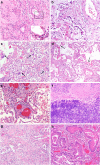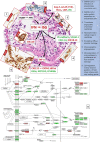The pulmonary pathology of COVID-19
- PMID: 33604758
- PMCID: PMC7892326
- DOI: 10.1007/s00428-021-03053-1
The pulmonary pathology of COVID-19
Abstract
The lung is the main affected organ in severe coronavirus disease 2019 (COVID-19) caused by the novel coronavirus SARS-CoV-2, and lung damage is the leading cause of death in the vast majority of patients. Mainly based on results obtained by autopsies, the seminal features of fatal COVID-19 have been described by many groups worldwide. Early changes encompass edema, epithelial damage, and capillaritis/endothelialitis, frequently combined with microthrombosis. Subsequently, patients with manifest respiratory insufficiency exhibit exudative diffuse alveolar damage (DAD) with hyaline membrane formation and pneumocyte type 2 hyperplasia, variably complicated by superinfection, which may progress to organizing/fibrotic stage DAD. These features, however, are not specific for COVID-19 and can be found in other disorders including viral infections. Clinically, the early disease stage of severe COVID-19 is characterized by high viral load, lymphopenia, massive secretion of pro-inflammatory cytokines and hypercoagulability, documented by elevated D-dimers and an increased frequency of thrombotic and thromboembolic events, whereas virus loads and cytokine levels tend to decrease in late disease stages, when tissue repair including angiogenesis prevails. The present review describes the spectrum of lung pathology based on the current literature and the authors' personal experience derived from clinical autopsies, and tries to summarize our current understanding and open questions of the pathophysiology of severe pulmonary COVID-19.
Keywords: Autopsy; COVID-19; Diffuse alveolar damage; Pulmonary disease; SARS-CoV-2.
Conflict of interest statement
The authors declare no conflict of interest.
Figures


References
-
- Wu F, Zhao S, Yu B, Chen YM, Wang W, Song ZG, Hu Y, Tao ZW, Tian JH, Pei YY, Yuan ML, Zhang YL, Dai FH, Liu Y, Wang QM, Zheng JJ, Xu L, Holmes EC, Zhang YZ. A new coronavirus associated with human respiratory disease in China. Nature. 2020;579:265–269. doi: 10.1038/s41586-020-2008-3. - DOI - PMC - PubMed
Publication types
MeSH terms
LinkOut - more resources
Full Text Sources
Other Literature Sources
Medical
Miscellaneous

